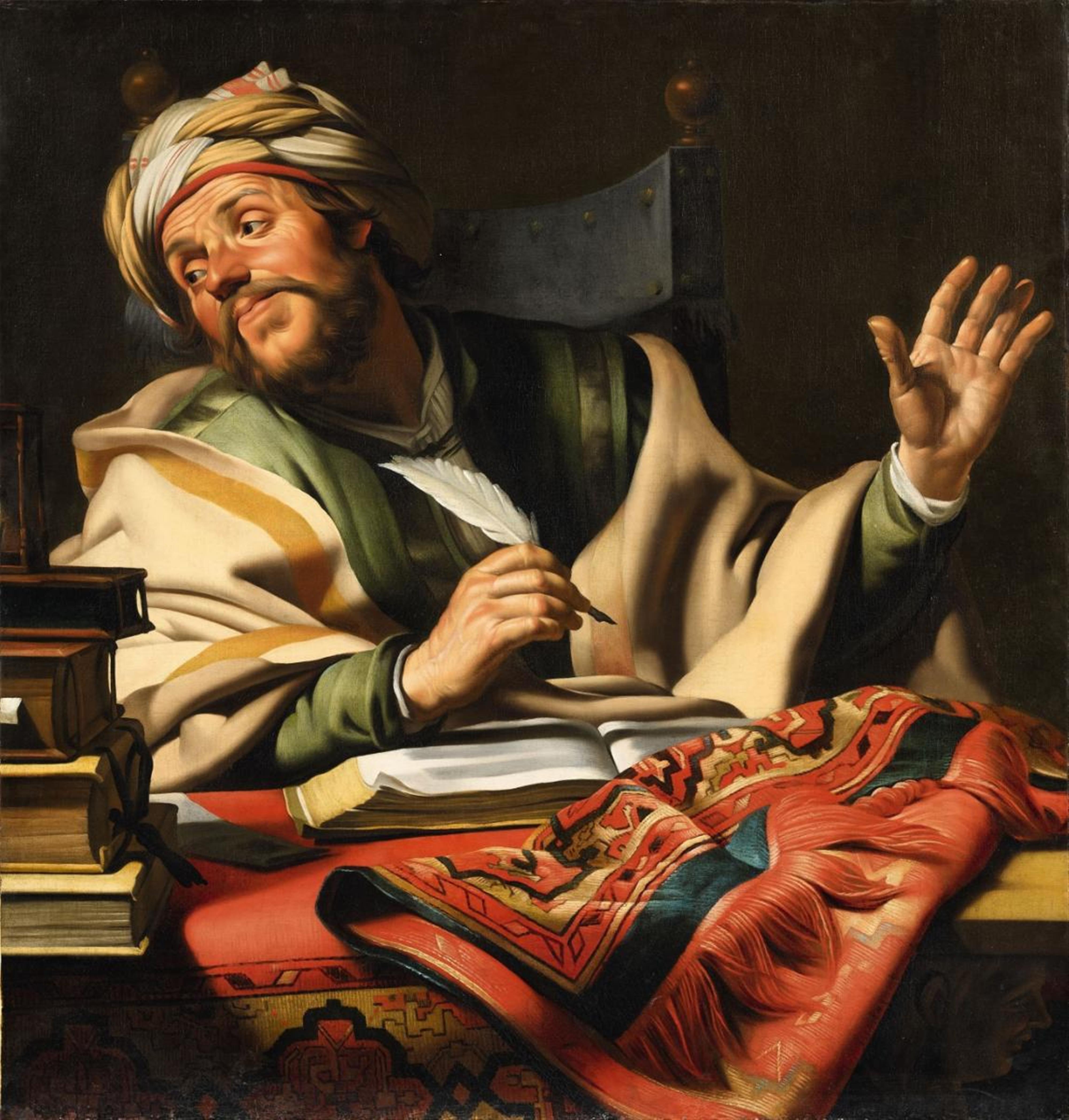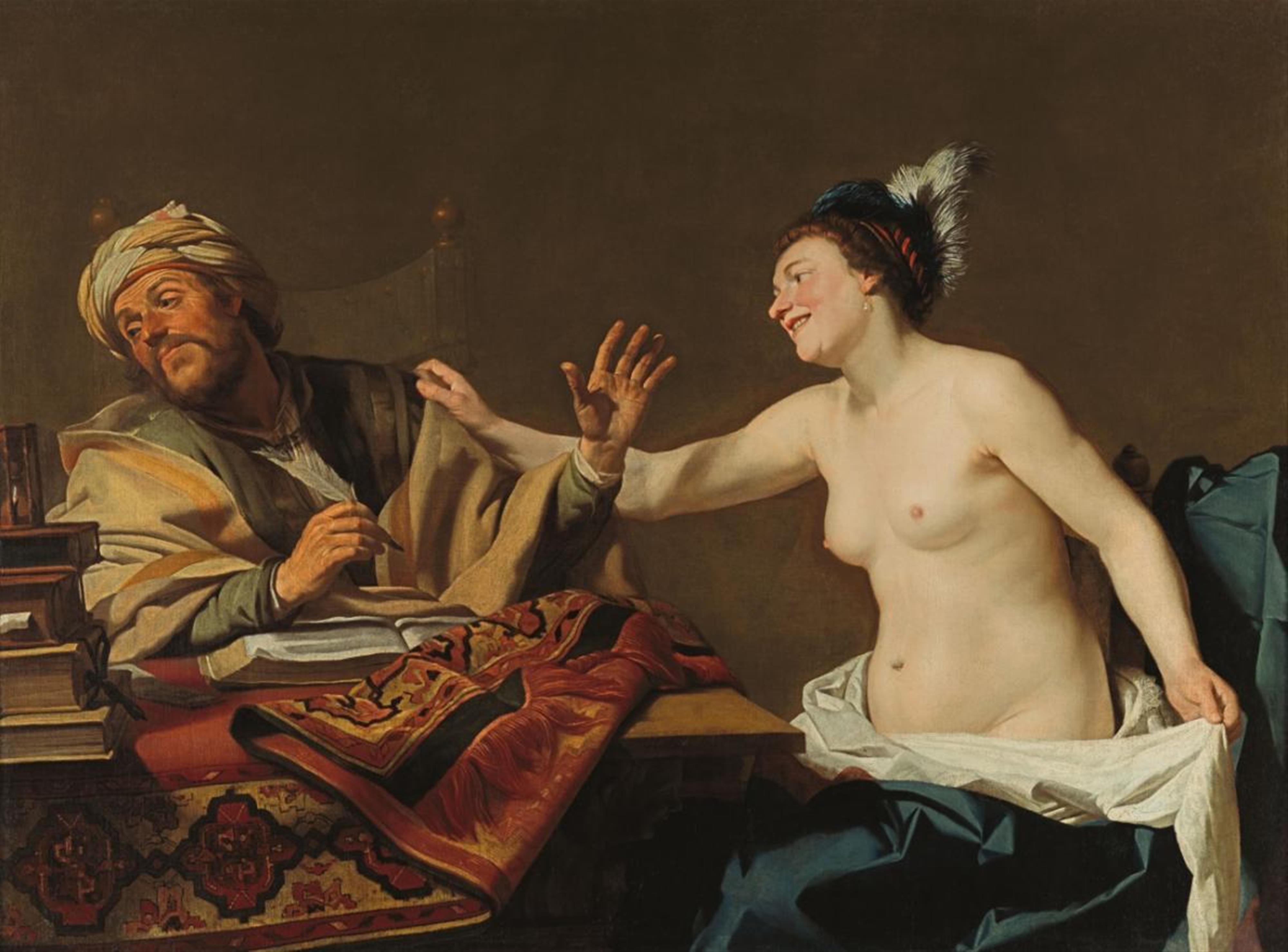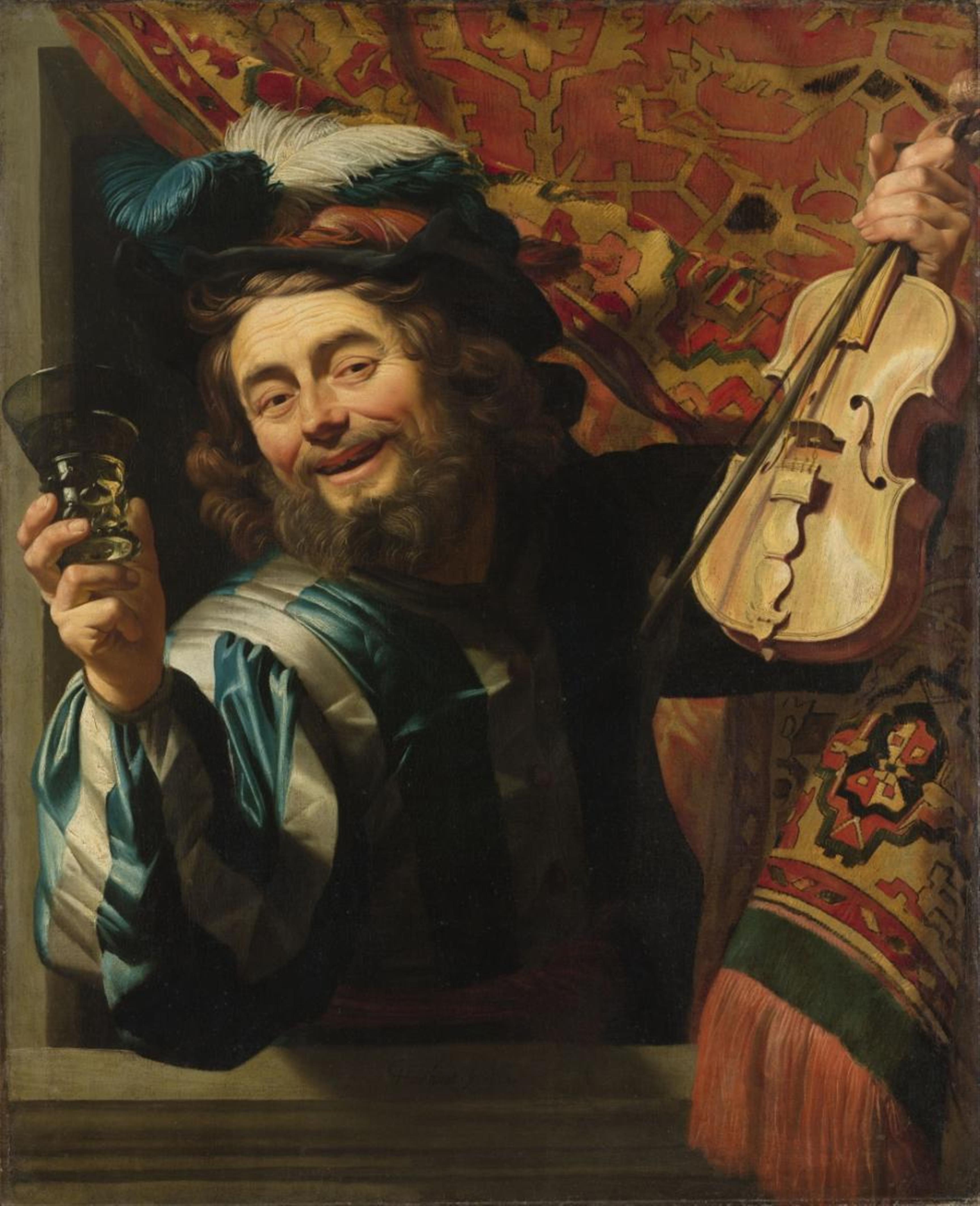Gerrit van Honthorst
The Steadfast Philosopher
Oil on canvas (relined). 107 x 102 cm.
This work depicts a man sitting at a desk which is strewn with a rug and a pile of books and where he has apparently been writing, as he is holding a quill in his right hand and has an open book lain out before him. However, he is not shown leant over his work, but rather with his left hand raised and his head turned to the right.
The meaning behind the title of Gerrit van Honthorst's painting “The Steadfast Philosopher” is not immediately clear upon mere inspection of the work, but reveals itself through the knowledge that the painting is a version by the artist himself of a piece kept in the Hohenbuchau Collection (cf. J. Richard Judson: Gerrit van Honthorst, with catalogue raisonné, Doornspijk 1999, no.157, p. 137/38, illus. IX and 73.). This composition includes the additional figure of a half naked young woman to the right. The girl has let her dress fall down to her waist and smiles seductively, nearing the man with blatantly impure intent. However, her charm fails in its purpose, as the scholar turns away, not allowing himself to be distracted from his studies. Art historians have long pondered over the iconography of this image. The popular biblical story of Joseph and Potiphar's wife has been suggested (and subsequently rejected, as the man in the painting is too old to represent the young Joseph), but also the story of Xenokrates and Phryne, which is more fitting. In the end, historians have settled on the more neutral title “The Steadfast Philosopher”, which Judson also used for this single figure composition in his catalogue raisonné (Judson/Ekkart, op. cit., p. 138).
This depiction of a philosopher illustrates the qualities for which Gerrit van Honthorst's art was celebrated by his contemporaries. These were qualities which he developed through study of the works of Caravaggio and his followers during a sojourn to Rome between 1612 and 1620 - namely the dynamic and monumental way of depicting figures and lifelike corporeality through the skilful use of light and shadow. The mere addition of the folded red carpet in the foreground creates the appearance of immense depth and the figure is provided with a powerful tangibility through the generous drapery of the philosopher's ochre-coloured cloak and the chiaroscuro effect with which Honthorst has modelled for instance his raised hand.
In this painting, Gerrit van Honthorst has not simply repeated the left half of the work in the Hohenbuchau Collection and left out the woman, but has tightened the frame around the subject to bring the figure closer to the viewer. This effect is accentuated by the rug in the foreground, which is now cut off by the edge of the image and serves as repoussoir. This tighter composition focussing on a single figure further enhances the dynamic and lifelike appearance of Honthorst's philosopher. The artist has used a technique which we also see in the paintings of musicians he developed in the early 1620s after his return from Rome. The depiction of individual musicians developed from the separation of single figures from groups, a motif originating in the work of the Italian Caravagesques but with its roots in the painting tradition north of the Alps. A fine example of this kind of work is the “Merry Fiddler with Wine Glass” (cf. illus. 2; oil on canvas, 108 x 89 cm, Rijksmuseum, Amsterdam, inv. SK-A-180), a painting with near identical dimensions to the present work. Despite their many differences, Gerrit van Honthorst has utilised the same style of composition in “The Steadfast Philosopher” as he does in his pictures of musicians such as the “Merry Fiddler”: He has isolated a single figure from a larger compositional and narrative programme and made it the protagonist of an imposing, life size depiction.
In his “Schilderboek“ of 1603, the art theoretician Karel van Mander described the life of Michelangelo Merisi da Caravaggio, the brightest star among the painters of Rome, and recommended that young artists emulate his style, if not his questionable life choices. Inspired by such reports, a whole generation of young, talented artists - all of whom born in the 1580s and 1590s - made the journey from Utrecht to Rome to study the art of this great master, among them Hendrik Terbrugghen, Dirck van Baburen, Jan van Bylert and Gerrit van Honthorst. Caravaggio himself died in 1610, but the Netherlandish artists were able to study his works in the churches and collections of the city. Painters throughout Italy and the whole of Europe, including Orazio Gentileschi, Bartolomeo Manfredi, Valentin de Boulogne and Jusepe Ribera also continued to paint in Caravaggio's style. Gerrit van Honthorst lived in the house of Cardinal Giustininani, who owned a substantial collection of art and whose palace was located directly opposite the Church of San Luigi dei Francesi in which many of Caravaggios finest works were kept. Here, the artist was able to study his paintings as well as those of numerous other Italian artists, such as Annibale Carracci and his pupils, and Honthorst became a highly sought-after painter in Rome, particularly of religious subjects. He returned to Utrecht a successful painter in 1620, bringing his new style and motifs from Italy with him, and it was shortly after this return that he painted “The Steadfast Philosopher”.
Provenance
Auctioned by Keller & Reiner, Berlin, 6./7.3.108, lot 89. - Binder collection, Berlin. - Elstor collection, Hannover. - Alberto Antonino art dealers, Torre Canavese.
Literature
A. von Schneider: Caravaggio und die Niederländer. Marburg 1933, p. 134. - J. Richard Judson: Gerrit van Honthorst. A Discussion of his Position in Dutch Art. Den Haag 1959, p. 194. - H. Braun: Gerard und Willem van Honthorst. Diss. Göttingen. Göttingen 1966, p. 179. - J. Richard Judson u. Rudolf E.O. Ekkart: Gerrit van Honthorst 1592 - 1656. Doornspijk 1999, p. 138, illus. 74.






